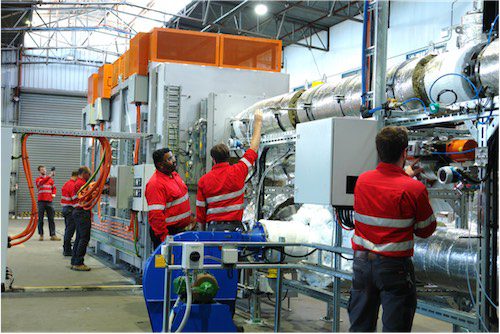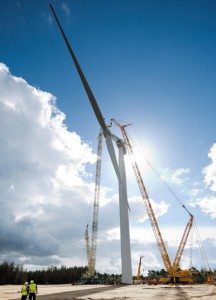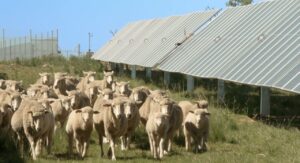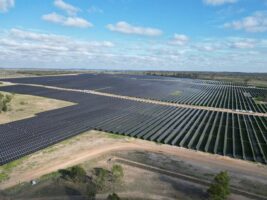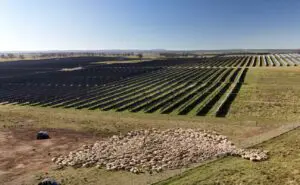Australian thermal energy storage hopeful 1414 Degrees has reached a key milestone after taking its molten silicon-based technology to the temperature levels required to replace burning fossil fuels in industrial processes.
In an announcement on Monday, the company said its silicon storage media was heated to 1414°C – the melting point of silicon promised in the company’s name – in tests using its SiBox Demonstration Module.
1414 Degrees’ chair Kevin Moriarty says this is a milestone achievement for its high energy density bricks, currently dubbed 14D Brick, because they have done this in the presence of air that has previously proven to be very destructive of silicon storage media.
Over its lifetime, 14D has explored a few options for its technology, including long duration energy storage – electricity to electricity – and a South Australia government-sponsored attempt at storing biogas as thermal energy, that was not a success.
In 2023, the company has retrained its focus on using the “unique thermophysical properties” of its technology to supply industrial heat of the sort that is currently supplied using carbon-intensive processes fuelled by gas and coal.
Having now successfully demonstrated in its lab-based furnaces that it can reach the sort of temperature levels, between 800°C – 1200°C, required for heavy industrial processes, the next step is to generate that sort of heat continuously over extended periods of time.
The welcome sign of progress for 14D follows a bumpy few years. In mid-2020 the company issued a refreshingly frank appraisal of its technology that found it falling short on key efficiency and reliability metrics and “not currently competitive” with fossil fuel heating.
“Our engineers and scientists have put in a remarkable effort in the past three years to get to this point,” says 14D chair Kevin Moriarty this week, giving thanks to key funding support from the federal government and technology partners like gas giant Woodside Energy.
“The next milestone will be demonstrating long-term stability in multiple cycling tests within our SiBox module.”
Moriarty says the size and shape of the 14D Brick – the company has called on shareholders to help find a better name for the patent pending technology – can be varied to requirements by extending the brick’s walls to increase storage to larger scale.

He says the next commercial stage will be 20 to 100 times larger to supply heat to an industrial process, with the company currently in discussions with end users in the minerals and cement production industry to determine process design requirements.
“What we’ll be doing is charging up during the day when when energy prices a low and then we’ll be discharging … when the prices are high to test it out,” Moriarty tells RenewEconomy.
“But we won’t be generating electricity …we will just be outputting the heat,” a process he says is also known is indirect burning.
“And then we’ll be keeping it going for at least 12 months to test out both the storage media and the efficiency and … to get the performance metrics,” Moriarty says.
“That’s what industrials want to see. That’s what our technology partners want to see, like Woodside Energy.
“So it’s about putting it through operational testing,” he adds. “We’ve certainly cycled it here [in our lab] in a static state, but here’s where we’re putting it to work.”
Moriarty says that, all going to plan, the 14D Bricks could be used to supply industrial heat for a wide range of major emissions intensive industries seeking to survive and thrive in a carbon constrained market.
“Alumina is one of the industries that we can see an immediate use [for the SiBox) …making aluminium and and or at least the raw material for aluminium and cement.
“There’s two aspects to our storage: one is where we we can provide that high temperature hot air to replace burning gas, for example, but the other is where our bricks can be used by the industries themselves to increase the efficiency of their regenerative heat, or take it to a higher temperature.
“So we would we would envisage selling, you know, millions of the bricks that we’re developing into those industries, to use in their in their plants, but also to provide them with the… very large SiBox style plants as well to provide the heat directly.”
14D has other irons in the fire, too, having in 2019 made the strategic purchase of the Aurora Energy Project (AEP) near Port Augusta, taking up existing plans to develop a hybrid solar energy generation project.
Last year, Sydney-based concentrated solar outfit Vast Solar bought 50% of the shares in Silicon Aurora, the 14D subsidiary leading the Aurora Energy Project, which will feature a combination of solar thermal, PV, and battery technologies.
14D said this week that, once ready for commercialisation, the AEP site would also allow the company to pilot and demonstrate a large commercial scale version of its SiBox technology.
On the company’s past experimental forays and logistical ups and downs, Moriarty is philosophical.
“One was we had been asked to burn biogas and store the energy and regenerate it as electricity. In a nutshell, that didn’t work. It didn’t work economically. And it didn’t work physically.
“But we were also working out that… regenerating electricity as electricity was not the best way to go. So we’’ve been targeting – along with the federal government and Woodside Energy – industrial heat.
“We knew, then, it was the future, but it’s taken a while for the world to sort of catch on.”

